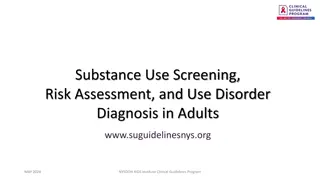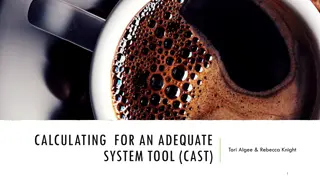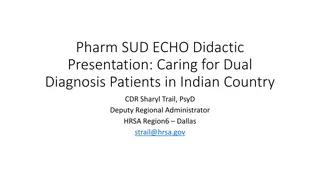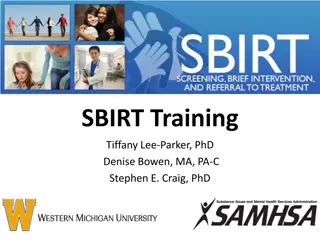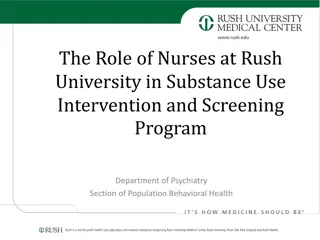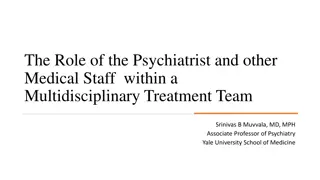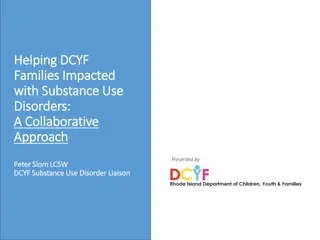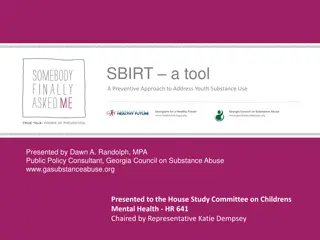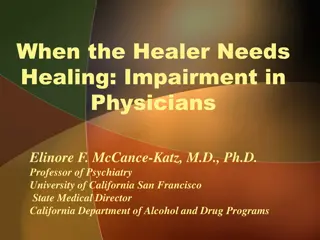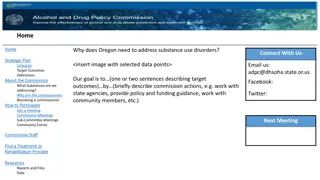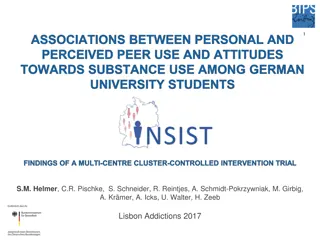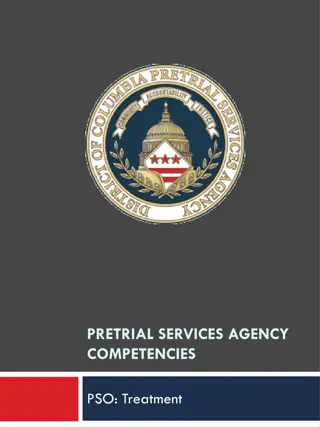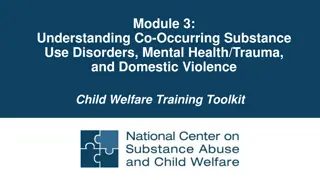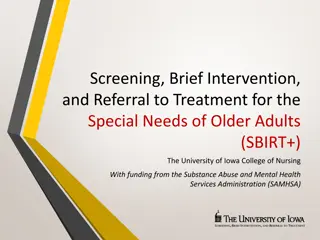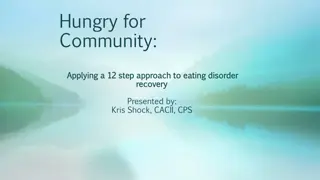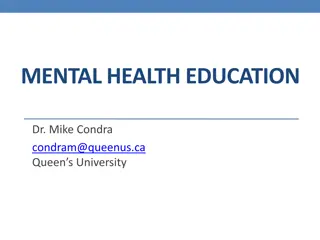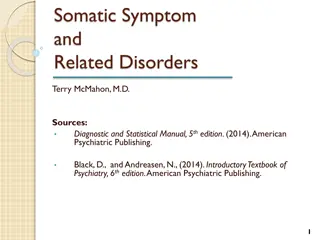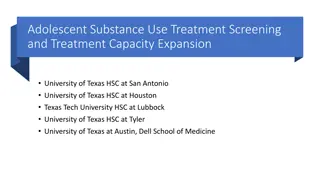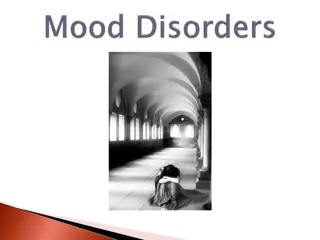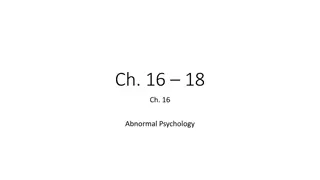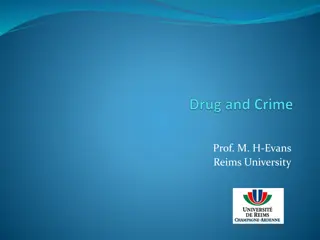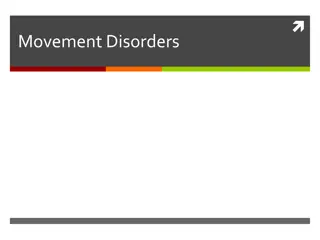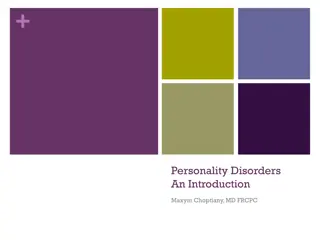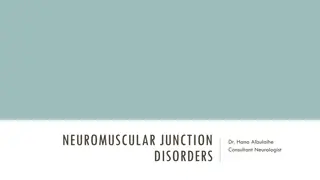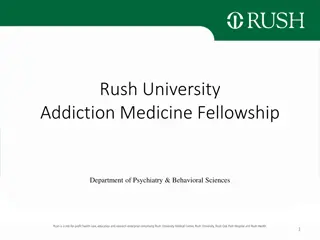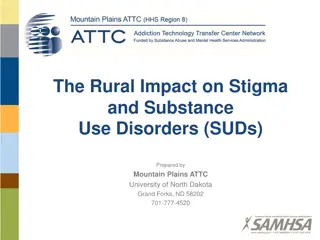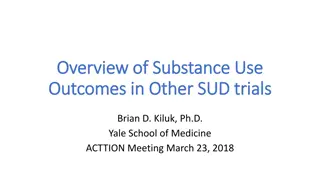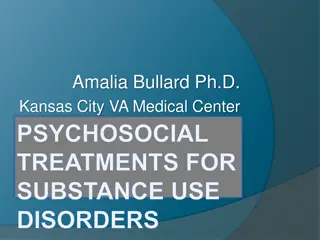Understanding Substance Use Disorders and Associated Factors
Substance use disorders encompass conditions arising from the abuse of alcohol, psychoactive drugs, and other chemicals, leading to physical and psychological dependencies with withdrawal symptoms upon cessation. Psychological factors such as inferiority complex and poor impulse control, along with social influences like peer pressure and easy availability of drugs, contribute to the development of substance abuse. Recognizing these factors is crucial in addressing and managing substance use disorders effectively.
Download Presentation

Please find below an Image/Link to download the presentation.
The content on the website is provided AS IS for your information and personal use only. It may not be sold, licensed, or shared on other websites without obtaining consent from the author. Download presentation by click this link. If you encounter any issues during the download, it is possible that the publisher has removed the file from their server.
E N D
Presentation Transcript
Substance Use Disorders
SUBSTANCE ABUSE Disorders due to psychoactive substance use Conditions arising from the abuse of alcohol, psychoactive drugs & other chemicals Substance refers to any drugs, medication, or toxins that shares the potential of abuse. Addiction is a physiological & psychological dependence on alcohol or other drugs of abuse that affects the central nervous system in such a way that withdrawal symptoms are experienced when the substance is discontinued.
Abuse refers to maladaptive pattern of substance use that impairs health in a board sense. Dependence refers to certain physiological & psychological phenomena induced by the repeated taking of a substance. Tolerance is a state in which after repeated administration, a drug produced a decreased effect, or increasing doses are required to produce the same effect. Withdrawal state is a group of signs & symptoms recurring when a drug is reduced in amount or withdrawn, which last for a limited time.
ICD 10 CLASSIFICATION F10 F19 Mental & Behavior Disorders due to Psychoactive Substance Use. F10 - Behavior Disorders due to use of Alcohol. F11 - Behavior Disorders due to use of Opioids. F12 - Disorders due to use of Cannabinoids. F13 - Mental & Behavior Disorders due to use of Sedatives & Hypnotics. F14 - Behavior Disorders due to use of Cocaine. F16 - Disorders due to use of Hallucinogens.
PSYCHOLOGICAL FACTORS General rebelliousness Sense of inferiority Poor impulse control Low self-esteem Inability to cope up with the pressures of living & society (poor stress management skills) Loneliness, unmet needs Desire to escape from reality Desire to experiment, a sense of adventure Pleasure seeking Sexual immaturity
SOCIAL FACTORS Religious reasons, peer pressure Urbanization, extended period of education Unemployment, overcrowding Poor social support Effects of television & other mass media Occupation: substance use is more common among chefs, barmen, executives, salesman, actors, entertainers, army personnel, journalists, medical personnel, etc.,
EASY AVAILABILITY OF DRUGS Taking drugs prescribed by the doctors (benzodiazepine dependence) Taking drugs that can be bought legally without prescription (nicotine, opioids) Taking drugs that can be obtained from illicit sources (street drugs)
PSYCHIATRIC DISORDERS Substance use disorders are more common in depression, anxiety disorders (social phobia), personality disorders (especially anti-social personality), & occasionally in organic brain disorders & schizophrenia.
CONSEQUENCES OF SUBSTANCE ABUSE Leads to physical dependence, psychological dependence, or both. It may cause unhealthy lifestyles & behaviors such as poor diet. Chronic substance abuse impairs social & occupational functioning, creating personal, professional, financial, & legal problems (drug seeking is commonly associated with illegal activities, such as robbery or assault).
Drug use beginning in early adolescence may lead to emotional & behavioral problems, including depression, family problems with relations, problems with or failure to complete school, & chronic substance abuse problems. In pregnant women, substance abuse jeopardizes (danger of loss) fetal well-being. Psychoactive substances produce negative outcomes in many patients, including maladaptive behavior, drug induced psychosis Illicit street drugs pose added dangers; materials used to dilute them can cause toxic or allergic reactions.
ALCOHOL DEPENDENCE SYNDROME Excessive & compulsive drinking that produce disturbances in mental or cognitive level of functioning which interferes with social & economic levels. Types of drinkers Moderate drinkers - it does not cause much problems physically & mentally Problem drinkers - it cause impaired health, family & society Process of alcoholism Experimental stage Recreational stage Relaxation stage Compulsion stage
CAUSES OF ALCOHOLISM Hard physical labour Occupations like bar mates, medical professionals, journalists & actors A sudden loss of properties or closed ones. Ignorance Suddenly a person become a rich / poor. Disorders like depression, anxiety, phobia, & panic disorders. Biochemical factors (alterations in dopamine & epinephrine) Psychological factors (low self esteem, poor impulse, escape from reality, pleasure seeking). Social factors (over crowding, peer pleasure, urbanizations, religious reason, unemployment, poor social support, isolation).
STAGES OF ALCOHOLISM Progressive phase Crucial phase Chronic phase Rehabilitative phase Road for recovery
CLINICAL FEATURES OF ALCOHOL DEPENDENCE Minor complaints : (disquiet, indigestion, mood swings or depression, increased incidence of infection) Poor personal hygiene. Untreated injuries (cigarette burns, fractures, bruises that cannot be fully explained). Unusually high tolerance for sedatives & opioids. Nutritional deficiency (vitamins & minerals).
Secretive behavior (may attempt to hide disorder or alcohol supply). Consumption of alcohol- containing products (mouthwash, after-shave lotion, hair spray, lighter fluid, body spray, shampoos). Denial of problem Tendency to blame others & rationalize problems (problems displacing anger, guilt, or inadequacy onto others to avoid confronting illness).
ICD-10 CRITERIA FOR ALCOHOL DEPENDENCE A strong desire to take the substance Difficulty in controlling substance taking behavior A physiological withdrawal state. Progressive neglect of alternative pleasures or interests. Persisting with substance use despite clear evidence of harmful consequences
PSYCHIATRIC DISORDERS DUE TO ALCOHOL DEPENDENCE Acute intoxication Withdrawal syndrome Alcohol-induced amnestic disorders Alcohol-induced psychiatric disorders
ACUTE INTOXICATION Develops during or shortly after alcohol ingestion Clinically significant maladaptive behavior or psychological changes (inappropriate sexual or aggressive behavior) Mood lability Impaired judgment Slurred speech Inco-ordination Unsteady gait Impaired attention & memory Finally resulting in daze or coma
WITHDRAWAL SYNDROME Person who have been drinking heavily over a prolonged period of time, any rapid decrease in the amount of alcohol in the body is likely to produce withdrawal symptoms These are: Simple withdrawal symptoms Delirium tremens
SIMPLE WITHDRAWAL SYNDROME: Characterized by, Mild tremors Nausea Vomiting Weakness Irritability Insomnia Anxiety
DELIRIUM TREMENS Occurs usually within 2- 4days of complete or significant abstinence from heavy drinking. characterized by, A dramatic & rapidly changing picture of disordered mental activity, with clouding of consciousness & disorientation in time & place. Poor attention span Vivid hallucinations which are usually visual, tactile hallucinations can also occur. Severe psychomotor agitation
Shouting & evident fear Grossly tremulous hands which sometimes pick- up imaginary objects Autonomic disturbances such as sweating, fever, tachycardia, raised blood pressure Dehydration with electrolyte imbalances Reversal of sleep-wake pattern or insomnia Death may occur due to cardiovascular collapse, infection, hyperthermia, or self inflicted injury
ALCOHOL-INDUCED AMNESTIC DISORDERS Chronic alcohol abuse associated with thiamine deficiency (vitamin B) is the most frequent cause of amnestic disorders. This condition is divided into : Wernicke s syndrome Korsakoff s syndrome
WERNICKES SYNDROME Prominent cerebellar ataxia (uncoordinated muscle movement) Palsy of the 6th cranial nerve Peripheral neuropathy - a result of damage to the nerves located outside of the brain and spinal cord (peripheral nerves), often causes weakness, numbness and pain, usually in the hands and feet. Mental confusion
KORSAKOFFS SYNDROME Gross memory disturbance Disorientation Confusion Confabulation Poor attention span & distractibility Impairment of insight
ALCOHOL-INDUCED PSYCHIATRIC DISORDERS Alcohol induced dementia: It is a long term complication of alcohol abuse, characterized by global decrease in cognitive functioning (decreased intellectual functioning & memory) This disorder tends to improve with abstinence, but most of the patients may have permanent disabilities
Persistent Depression & Anxiety Suicidal behaviour Alcohol-induced anxiety disorders: panic attacks Impaired psychosexual dysfunction: erectile dysfunction & delayed ejaculation Pathological jealousy: delusion of unfaithfulness Alcoholic seizures: 1.Generalized tonic - clonic seizures occur within 12- 48 hours after a heavy bout of drinking. 2. Status epilepticus Alcoholic hallucinosis: 1.Presence of auditory hallucination during abstinence 2. Regular alcohol intake
RELAPSE The process of returning to the use of alcohol or drugs after a period of abstinence. Relapse dangers: The presence / proximity of drugs or alcohol, drug users, places where drugs were used. Negative feelings, anger, sadness, loneliness, guilt, fear, & anxiety Positive feelings which make you celebrate Boredom a state of feeling bored Increase the intake of drug Physical pain Lot of cash
Warning signs of relapse: Stopping medications on one s own or against the advise of medical professionals. Hanging around old drinking haunts & drug using friends. Isolating themselves Keeping alcohol, drugs around the houses Obsessive thinking about using drugs / drinking Fail to follow their treatment plan, quitting therapies, skipping doctor s appointments. Feeling over confident Difficulties in maintaining relationships
Warning signs of relapse (cont.) Setting unrealistic goals. Changes in diet, sleep, energy levels, & personal hygiene. Feeling overwhelmed. Constant boredom. Sudden changes in psychiatric symptoms. Unresolved conflicts. Avoidance. Major life changes loss, grief, trauma, painful emotions, winning the lotteries. Ignoring relapse warning signs & symptoms
Signs & symptoms of relapse: Experiencing post acute withdrawal Return to denial Avoidance & defensive behavior Starting to build crisis Feeling immobilized (stuck) Become depressed Loss of control Urges & cravings Chemical loss of control
COMPLICATIONS OF ALCOHOL ABUSE Gastro intestinal complications Chronic diarrhea, Esophagitis, Esophageal cancer, Esophageal varices, Gastric ulcers, Gastritis, Gastro intestinal bleeding, Malabsorption, Pancreatitis
COMPLICATIONS OF ALCOHOL ABUSE Neurologic complications Alcohol dementia, Alcoholic hallucinosis, Alcohol withdrawal delirium, Korsakoff s syndrome, Peripheral neuropathy, Seizure disorders, Subdural hematoma, Wernicke s encephalopathy
Cardiopulmonary complications Arrhythmias, Cardiomyopathy, Essential hypertension, Chronic obstructive pulmonary disease, Pneumonia, Increased risk of tuberculosis
Psychiatric complications A-motivational syndrome, Depression, Impaired social & occupational functioning, Multiple substance abuse, Suicide
Hepatic complications Alcoholic hepatitis, Cirrhosis, Fatty liver Other complications Beri beri, Fetal alcohol syndrome, Hypoglycemia, Leg & foot ulcers, Prosatitis
Diagnostic evaluation History collection. Mental status examination. Physical examination. Neurologic examination. Alcohol use disorders identification tests (AUDIT). Blood alcohol level to indicate intoxication (200mg/dl). Urine toxicology to reveal use of other drugs.
Diagnostic evaluation Serum electrolytes analysis- revealing electrolyte abnormalities associated with alcohol use. Liver function studies demonstrating alcohol related liver damage. Hematologic workup possibly revealing anemia, Echocardiography & electrocardiography demonstrating cardiac problems. Based on ICD10 criteria.
Treatment modalities Symptomatic treatment. Fluid replacement therapy. IV glucose to prevent hypoglycemia. Correction of hypothermia / acidosis. Emergency measures for trauma, infection or GI bleeding.
PSYCHOLOGICAL THERAPY: Motivational interviewing Group therapy Aversive conditioning / therapy Cognitive therapy Relapse prevention technique: this technique helps the patient to identify high-risk relapse factors & develop strategies to deal with them.
PSYCHOLOGICAL THERAPY: Cue exposure technique: the technique aims through repeated exposure to desensitize drug abusers to drug effects, & thus improve their ability to remain abstinent. Assertive training Behavior counseling Supportive psychotherapy Individual psychotherapy


